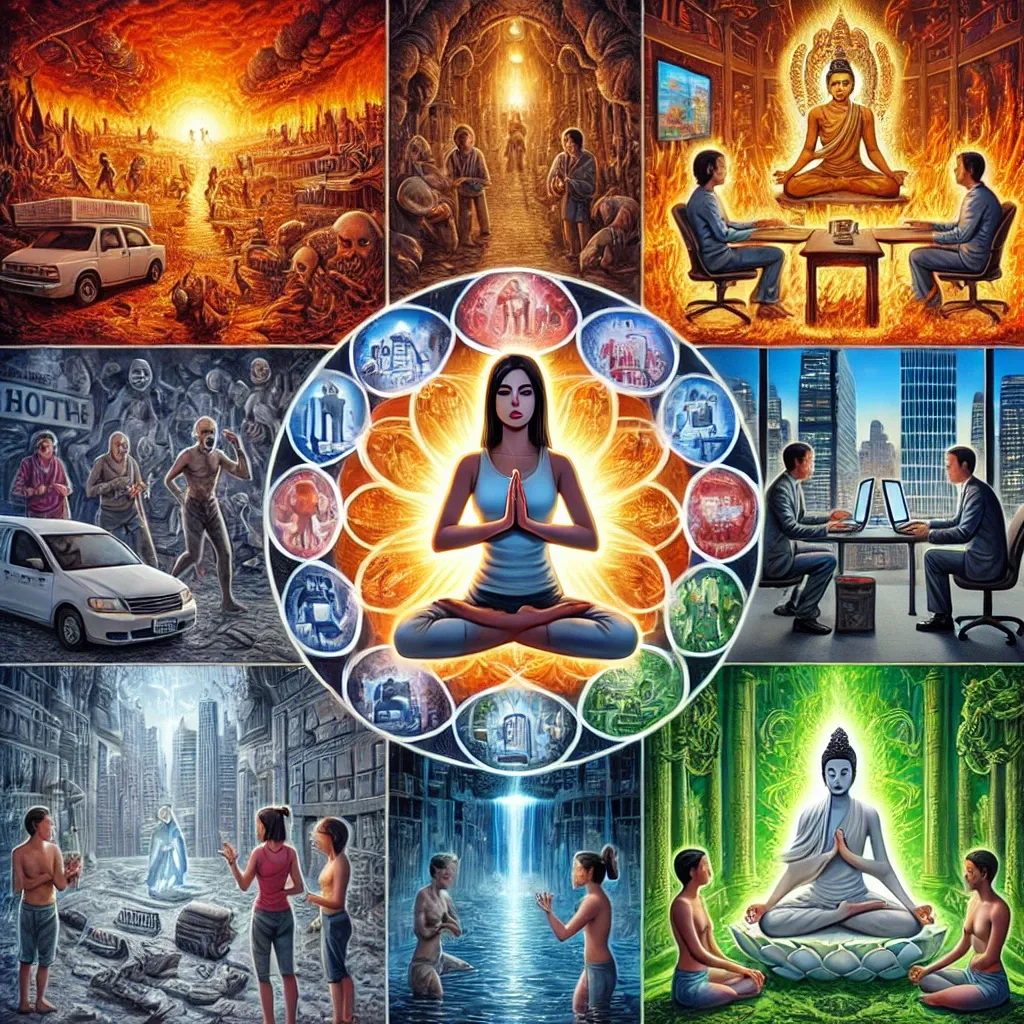The Six Realms of Suffering: A Buddhist Map of Unhealthy Psychological States
The Buddhist teaching of the Six Realms of Suffering is a profound exploration of the psychological structures that we can become trapped in. While some traditional Buddhists may have interpreted these realms as literal places of reincarnation, contemporary teachers such as Robert Thurman, Pema Chodron, and Jack Kornfield offer a more nuanced understanding. They see these realms as symbolic representations of the psycho-emotional states that we can find ourselves in when caught in cycles of unawareness or suffering.
One way to understand the Six Realms of Suffering is to view them as metaphorical landscapes that we create within ourselves. Just as Sogyal Rinpoche explains, we unconsciously allow our destructive emotions to shape the world around us, defining the context of our lives within these realms. These states are not external locations but internal experiences that influence how we think, feel, and act.
It is possible for individuals to be predominantly stuck in one realm or to cycle through several realms in a single day. The key to liberation lies in cultivating self-awareness. By recognizing the ways in which these realms influence our perceptions and behaviors, we can begin to break free from their hold and regain conscious control over our lives. These states are impermanent, and by seeing through their illusion, we can rediscover our natural wakefulness and enlightened essence.
Perceptions Create The Reality We Live In
Buddhist teacher Chögyam Trungpa emphasized the power of perception in shaping our reality. He taught that we do not simply reflect the world around us but actively create it through our perceptions. We project our hopes and fears onto the neutral field of experience, turning it into our personal drama. Our past conditioning and emotional filters define how we interpret each moment, determining whether we experience life as heaven or hell.
In essence, what we pay attention to becomes the world we inhabit. By becoming aware of the ways in which our perceptions shape our reality, we can begin to transform our experience and live more consciously. By recognizing the power of our minds to create our world, we can start to break free from the confines of the Six Realms of Suffering and live with greater freedom and clarity. In the depths of our minds lie the Six Realms of Suffering, each representing a different state of mental anguish that we may find ourselves trapped in. These realms, such as the Hell Realm and the Hungry Ghost Realm, are characterized by intense emotions and desires that keep us locked in a cycle of suffering. But through the practice of meditation, we can break free from these chains and find liberation from our own mental prisons.
The Hell Realm, for example, is a state of burning anger and hatred. When we are consumed by rage or resentment, we feel like we are trapped in a fiery pit of our own making. But by approaching our anger with mindfulness and compassion, we can see that it is just a temporary emotion that does not define us. Through meditation, we can create space for our anger to dissipate and find peace within ourselves.
Similarly, the Hungry Ghost Realm represents insatiable desire and addiction. We are constantly seeking to fill a void within ourselves with external pleasures, but no matter how much we consume, the emptiness remains. By practicing gratitude and contentment through meditation, we can learn to appreciate the completeness of the present moment and break free from the cycle of craving.
Meditation is a powerful tool that allows us to step back from our projections and dissolve the filters that cloud our perception of reality. By observing our thoughts and emotions without judgment, we can uncover the luminous reality that has always been there beneath our assumptions. Through this practice, we can find freedom from the Six Realms of Suffering and discover the peace and clarity that exist within us all. The Deva Realm – The State of Bliss and Contentment
The Deva Realm is known for its beauty, joy, and abundance. In this realm, beings experience a sense of lightness, freedom, and pleasure. However, this realm also carries the danger of arrogance and complacency.
When we become too comfortable in the Deva Realm, we may lose touch with the reality of suffering and impermanence. We may start to believe that we are superior to others, leading to a sense of entitlement and disconnection from the struggles of those in lower realms.
Meditation serves as a humbling practice in the Deva Realm. By tuning into our breath, body, and heart, we shift from “not enough” to “this is enough” and we discover the natural perfection within the moment. This practice reminds us that true contentment comes from within, not from external sources.
In the Deva Realm, meditation helps us cultivate gratitude, humility, and compassion. It allows us to appreciate the beauty around us without becoming attached to it. By staying present and grounded in the present moment, we can experience true bliss and contentment that is not dependent on external circumstances.
In the end, meditation is a powerful tool for navigating the different realms of existence. By practicing awareness and presence, we can find balance, clarity, and peace in all aspects of our lives. Whether we find ourselves in the Animal Realm, Human Realm, or Deva Realm, meditation offers a path to liberation and enlightenment.

